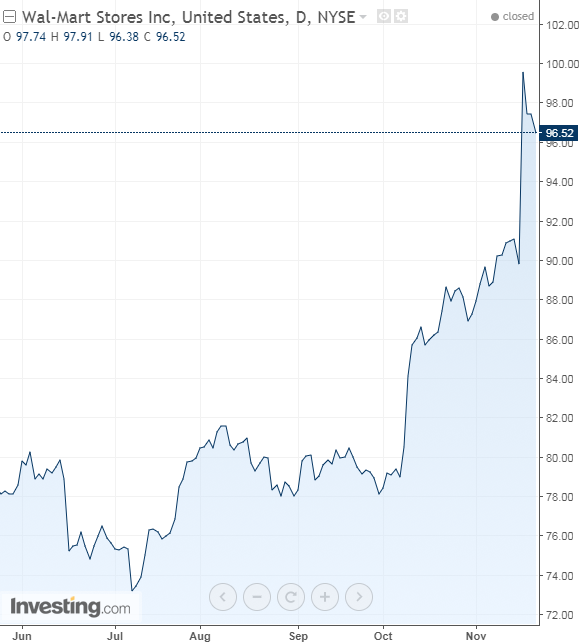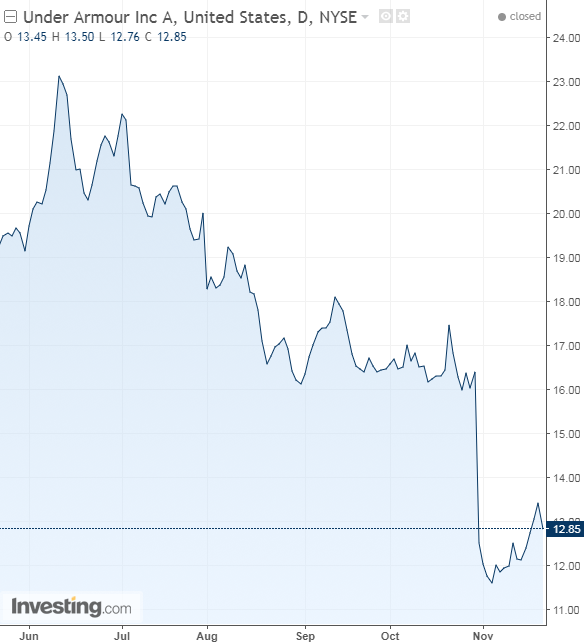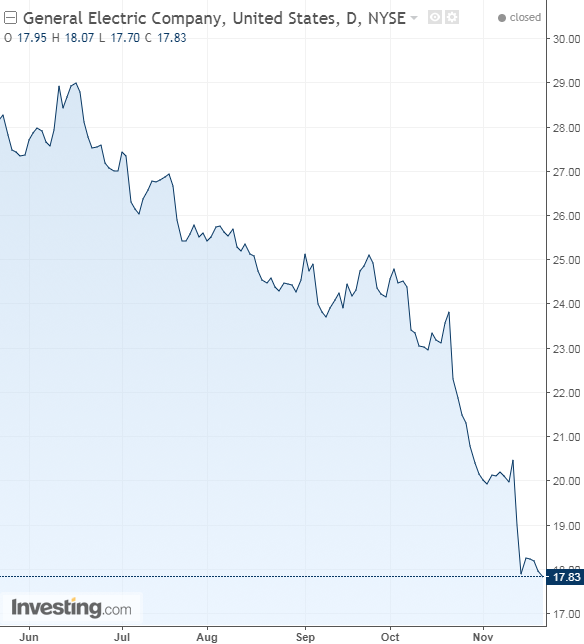by Clement Thibault
Another earnings season is behind us and what a season it was. The S&P 500 and Dow Jones were propelled to new highs and based on Q3 results, corporate earnings are on the rise. According to our data, there were twice as many earnings beats as misses.
While some companies did extraordinarily well, others seriously disappointed. As a rule, analysts aren't generally expecting a particular number, rather more of a range. So as long as results fall within that range, a stock carries on normally. However, when companies really surprise—either to the upside or the downside—or better yet, an executive prognosticates on future performance during a company's earnings call, that’s when sparks can really fly.
To close the Q3 earnings season, here's a look at the five biggest winners and losers. Our list moves through the top and bottom five in ascending order:
Winners
5. Foot Locker
Close before earnings - $31.8; after earnings - $40.8, +28.1%
Foot Locker (NYSE:FL), the sports shoe and apparel retailer, has been one of this year's worst performers, dropping from $77 a share in April to under $30 in November. The huge jump following earnings, was, unsurprisingly, a 'not-as-bad-as-expected' relief rally of sorts. Comparable sales fell by 3.7%, revenue is down 0.8% on the year, and even that relatively low number is because of favorable currency exchange on a weaking dollar. Without that FX assist, revenue would have been down 2.3%. When a stock falls so far so quickly, investors sometimes cling to any and every piece of good news, using it to drive the stock back up. This time, a $40 million beat on revenue ($1.87B vs 1.84B expected) did the trick, and the stock soared. 'Not-as-bad-as-expected' is generally seen as a good thing. Perhaps...for a day or two. But overall, Foot Locker remains in a very precarious situation. As investors, we'd stay away.
4. Amazon
Close before earnings - $972; after earnings - $1100, +13.1%
When shares of a company already worth hundreds of billions of dollars jumps an additional 13%, you know something big has happened. First, Amazon (NASDAQ:AMZN), the online retailing heavyweight, reported $43.7 billion dollars in revenue this quarter, which, even as a standalone number, is awe inspiring.
That number was good for 34% growth over the last year, 29% without the Whole Foods acquisition. Amazon Prime Day took place during the quarter too, and the holiday season is just ahead, so the retail operation is firing on all cylinders. AWS, Amazon's cloud service segment, brought in $1.2 billion in operating revenue, making up for the loss $900 million loss from Amazon's International segment.
As long as AWS keeps growing at a 40%+ rate, Amazon is solid.
3. Intel
Close before earnings - $43.1; after earnings - $44.4, +7.5%
A strong quarter from an underpriced company such as Intel (NASDAQ:INTC) is always a good recipe for a nice jump in the share price. Which is just what happened. Intel's price was kept low by concerns related to the competitive environment among chipmakers. To put it more succinctly, two things were of concern: NVIDIA (NASDAQ:NVDA) and Advanced Micro Devices (NASDAQ:AMD). Notwithstanding the competition, the semiconductor giant proved its ability to grow despite competitive headwinds, posting $16.1 billion in revenue and $1.01 in EPS, compared to the $15.7 billion and $0.8 EPS Wall Street expected. Data Center revenue was up 7%, Internet of Things revenue jumped 23%, and revenue related to its memory group segment rose 37%. All that was already good, and with a raise in guidance for Q4, Intel shares jumped more than 7% on the day of the report.
2. First Solar
Close before earnings - $47.9; after earnings - $57.6, +20.2%

First Solar's (NASDAQ:FSLR) 20% jump had a lot to do with stellar earnings. Its revenue jumped 59% and net income came in 37% higher compared to last year. EPS was $1.95 when Wall Street expected $0.83, so a massive beat indeed for Elon Musk's solar energy company. However, it is worth noting that some of next quarter's revenue was pulled into this quarter, creating a stronger beat. First Solar is benefiting from a global sentiment change regarding green energy, as well as specifically a policy proposal by US President Donald Trump to impose tariffs on solar panels, which potentially bolsters the attractiveness of First Solar's product.
1. Walmart
Close before earnings - $89.8; after earnings - $99.6, +10.9%

Those calling for the demise of the bricks-and-mortar retail sector widely underestimate sector participants' resolve to remain on the map—perhaps most especially that of retail behemoth Walmart (NYSE:WMT). Comparable sales, the key metric for companies with physical locations, rose 2.7%, the best figure in eight years. Walmart beat revenue expected by more than a full $2 billion, as it reported $123.2 billion to the $121 billion expected. If that wasn't enough, Walmart reported a 50% jump in online sales, proving to the world that it can and will adapt to the new e-commerce reality. The earnings beat propelled Walmart shares to a new all-time high, so a small pullback would be expected, which could act as a good entry point.
Losers
5. Merck
Close before earnings - $61.9; after earnings - $58.2, -5.9%
While Merck (NYSE:MRK) shares closed the day of its earnings report at $58.2, shares of the global pharmaceuticals giant fell the following day to $55, slicing another 5% off the company's valuation. Merck missed revenue expectations, reporting $10.3 billion instead of the $10.5 billion Wall Street was looking for. Merck has a few top-tier drugs such as Zepatier (HCV) for chronic hepatitis as well as a variety of diabetes meds, which going forward will all be affected by competition. Perhaps more significant, Merck announced delays in trail results for its lung cancer drug Keytruda and withdrew an application to market the drug in the European Union. This news brought a flurry of downgrades on the stock from several investment banks, spurring a serious drop in Merck's share price.
4. Chipotle Mexican Grill
Close before earnings - $324; after earnings - $277, -14.5%
Ever since sanitary issues began plaguing Chipotle (NYSE:CMG) in 2015, the Mexican restaurant chain hasn't been the same. The e-coli outbreak in its grills, which erupted two years ago, continues to have an adverse effect on Chipotle's share price, and the company continues to struggle to re-establish itself as an appealing destination for consumers. The $1.13 billion the company reported in revenue fell short of analyst expectations, which stood at $1.14 billion. That $1.13 billion is also lower than the $1.2 billion Chipotle reported before the e-coli fiasco. That means, of course, that even two years later it still hasn't managed to return to the point at which all the trouble started, let alone grow. Adding insult to injury: guidance for new restaurant openings has been lowered for the remainder of 2017 and 2018.
3. AMD
Close before earnings - $14.2; after earnings - $12.3, -12.1%
The problem with Advanced Micro Devices is very simple: investors expected way too much from the chipmaker, which has been on the comeback trail since early 2016. Is AMD back for good? Possibly. It certainly deserves more than the $2 share price it sported at the beginning of last year. The company beat estimates this quarter, reporting $1.64 billion in revenue compared to the $1.51 billion analysts were forecasting. However, when expectations are high, even a strong beat isn't enough. Moreover, the company only slightly raised its forecast for the coming quarter, leading investors to fear a decline in growth—which led to a slide in the stock price. Generally, we're not fans of companies in the red that have lofty valuations on "future earnings". When AMD starts posting a real quarterly benefit once more, we'll reconsider.
2. Under Armour
Close before earnings - $14.7; after earnings - $11.5, -21.7%

Under Armour (NYSE:UAA), the exercise apparel and footwear specialty chain, is in big trouble. Its largest segment is North America, and unfortunately, the sportswear retail environment outlook isn't optimal right now, with US consumers reining in spending and a long established Nike-Adidas stronghold in place. Sales fell 12% in North America during the third quarter. Overall, the company missed on revenue estimates, as it reported $1.4 billion versus the $1.49 billion expected. Even worse, the full year guidance was cut from 10% expected growth to the much vaguer (and more troubling) "low single digit". We don't foresee the business climate changing much in upcoming quarters, so it could take a year or more for Under Armour to regroup. It's strongly possible we haven't seen the stock's lowest lows yet.
1. General Electric
Close before earnings - $23.5; after earnings - $23.8, +1.2%

There's no real way to soften this assessment: General Electric (NYSE:GE) has been a chaotic disaster over the past few months. Key executives—including the company's chairman—leaving unexpectedly, earnings that disappointed even those with zero expectations, and perhaps the icing on the dysfunctional cake, a dividend cut that slashed the payout by half—from $0.96 a year, to $0.48. Earnings in Q3 were particularly bad: GE reported Q3 EPS of just $0.29 versus the expected $0.49. The full year outlook was subsequently trimmed from around $1.6 dollars per share to just $1.1 dollars per share. The international infrastructure and technology company, which is going through a substantial restructuring that will include the divestiture of underperforming segments under newly-appointed CEO John Flannery, is anything but a good, solid investment right now. Wait to see what the final, slimmed-down version of the company actually looks like before even thinking of proceeding.
